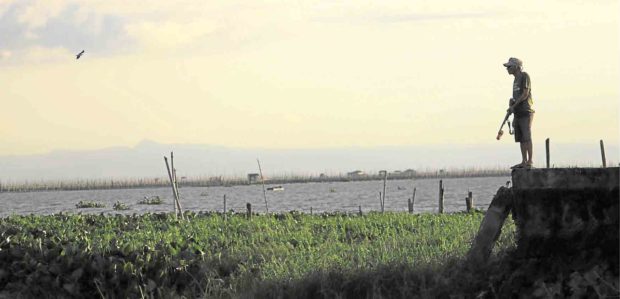
LAKE FISHING A man uses an air gun to catch fish in a section of Laguna de Bay in Binangonan town, Rizal province. The lake has reached its capacity this month due to heavy rains since July. —REM ZAMORA
Heavy rains since last month had pushed the water level in Laguna de Bay to rise and hit its maximum level sooner than what experts had expected.
With the heavy downpour triggered by Tropical Storm “Karding” (international name: Yagi) over the weekend, the lake reached its maximum height of 12.5 meters on Monday, according to the Laguna Lake Development Authority (LLDA).
The 12.5-m elevation is the lake’s maximum level annually, although this is usually recorded between October and November.
“It’s a bit too early,” said Emil Hernandez, LLDA hydrologist.
Already full
Hernandez said this meant that the lake’s “storage,” or water holding capacity of 2.2 billion cubic meters, had been reached, noting that the 90,000-hectare body of water was already full.
“Now, if [another] storm or habagat (monsoon rains) occurs in the coming weeks or months, flooding in shoreland areas is expected,” he said.
The combination of heavy rainfall and watershed runoff contributed to the rise of lake water, threatening a repeat of the 2009 flooding caused by Tropical Storm “Ondoy” (international name: Ketsana).
During Ondoy, the lake’s water level rose to as high as
14 m, submerging several parts of Metro Manila and Laguna province for months.
Hernandez said water level might decrease if the weather condition improved, but this would not be enough to allow more room for another round of heavy rainfall in the coming months.
Preemptive evacuation
In Binangonan, a lakeshore town in Rizal province, disaster response officer Jose Hernandez said residents noticed the lake rise, although the water had not spilled to shoreland.
The LLDA warned local governments to watch out for heavy rainfall warning and prepare for preemptive evacuation in the event of another weather disturbance.
The 90,000-ha lake, the Philippines’ largest inland water body, is surrounded by Metro Manila and the provinces of Laguna and Rizal.
The Regional Disaster Risk Reduction and Management Council (RDRRMC) in Calabarzon (Cavite, Laguna, Batangas, Rizal, Quezon) said heavily affected by the most recent monsoon rains were San Mateo and Rodriguez towns in Rizal.
State of calamity
San Mateo had been placed under a state of calamity, with knee- to chest-deep floodwaters hitting the villages of Guinayang, Guitnang Bayan and Maly, the RDRRMC said.
It said 5,239 families (25,562 people) remained in 28 evacuation centers in the town, among them the 482 detainees evacuated to Guitnang Bayan Elementary School after floods hit their prison cells.
In Rodriguez town, 2,863 families were still in 16 evacuation centers as of Monday.
A resident in San Mateo, Rizal province, tries to salvage her belongings from the muddy floodwaters that hit Banaba village. At right, a bridge in Alfonso, Cavite province, collapsed on Saturday due to erosion caused by monsoon rains. —PHOTOS BY JAM STA. ROSA AND MARIANNE BERMUDEZ
Floods hit three villages in Cainta town, the RDRRMC said.
Reports said floods also submerged villages in Santa Cruz town in Laguna; Nasugbu town in Batangas province; and the towns of Rosario, Noveleta and Tanza in Cavite province.
Authorities said 43 people and 20 sea vessels and boats were stranded at the ports at Calatagan and Tingloy in Batangas, and Infanta town in Quezon province.
Trixia Flores, Cavite disaster response officer, said 102 families (624 people) were still in evacuation centers in Tanza, while 81 families (277 people) remained in temporary shelters in Noveleta.
She said the concrete bridge spanning Esperanza and Mangas villages in Alfonso town collapsed on Saturday.